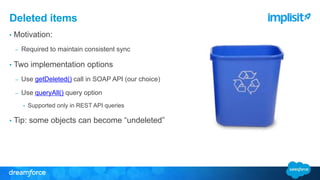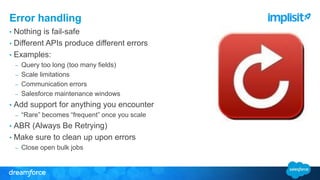Replicating One Billion Records with Minimal API Usage
- 1. How One Billion Salesforce records Can Be Replicated with Minimal API Usage Baruch Oxman R&D Manager, Implisit @implisithq, @baruchoxman
- 2. Safe Harbor Safe harbor statement under the Private Securities Litigation Reform Act of 1995: This presentation may contain forward-looking statements that involve risks, uncertainties, and assumptions. If any such uncertainties materialize or if any of the assumptions proves incorrect, the results of salesforce.com, inc. could differ materially from the results expressed or implied by the forward-looking statements we make. All statements other than statements of historical fact could be deemed forward-looking, including any projections of product or service availability, subscriber growth, earnings, revenues, or other financial items and any statements regarding strategies or plans of management for future operations, statements of belief, any statements concerning new, planned, or upgraded services or technology developments and customer contracts or use of our services. The risks and uncertainties referred to above include – but are not limited to – risks associated with developing and delivering new functionality for our service, new products and services, our new business model, our past operating losses, possible fluctuations in our operating results and rate of growth, interruptions or delays in our Web hosting, breach of our security measures, the outcome of any litigation, risks associated with completed and any possible mergers and acquisitions, the immature market in which we operate, our relatively limited operating history, our ability to expand, retain, and motivate our employees and manage our growth, new releases of our service and successful customer deployment, our limited history reselling non-salesforce.com products, and utilization and selling to larger enterprise customers. Further information on potential factors that could affect the financial results of salesforce.com, inc. is included in our annual report on Form 10-K for the most recent fiscal year and in our quarterly report on Form 10-Q for the most recent fiscal quarter. These documents and others containing important disclosures are available on the SEC Filings section of the Investor Information section of our Web site. Any unreleased services or features referenced in this or other presentations, press releases or public statements are not currently available and may not be delivered on time or at all. Customers who purchase our services should make the purchase decisions based upon features that are currently available. Salesforce.com, inc. assumes no obligation and does not intend to update these forward-looking statements.
- 3. Baruch Oxman R&D Manager
- 4. In this session… • Implisit - Intro & Motivation • Salesforce APIs Usage & Limits - Overview • Efficient use of Salesforce APIs • Scale and limitations • Other pitfalls and tips
- 5. Implisit – The End of CRM Data Entry • Using Data-Mining and Machine Learning techniques: – Automatic entry of emails and calendar events to Salesforce – Matching to relevant Accounts, Opportunities, Contacts, Leads – Automatic creation of missing Contacts & Leads • Using text analysis: – Creating meaningful business insights – Improving sales pipeline and forecasting • Requires Salesforce data replication for offline processing
- 6. Data Replication Goals • Minimize your API usage – Don’t reach the API limit – API limits are shared between all API-connected apps – other apps can become blocked • Minimize sync cycle time – Don’t make our customers wait for too long
- 7. Salesforce API Limits • Daily API limits for Salesforce Editions: – Unlimited/Performance: # of users x 5,000, up to 1,000,000 – Enterprise/Professional: # of users x 1,000 – Developer: 15,000 – Sandbox: 5,000,000 • In-parallel API calls limit (25 – production, 5 – dev) Source & more info: https://help.salesforce.com/HTViewHelpDoc?id=integrate_api_rate_limiting.htm
- 8. Performance Stats • Keeping over 1 billion Salesforce records replicated in-sync – 27 Salesforce object types are replicated • Initial sync – 600-1000 API calls in total • Updates sync – 200-400 API calls in total – Performed every few hours
- 10. Salesforce API Types • REST API – Fast, synchronous queries – Up to 2,000 records per request – Simple usage • SOAP API – describeSObjects – getDeleted – Other metadata queries • Bulk (Async) API – Large amounts of records in a single request – Slow, requires polling for results – Implements internal retries
- 11. So how do I replicate ?
- 12. Replication method – Initial fetching • Fetch all records for each relevant object type – Lots of data – Only non-deleted records • Break queried data into chunks, to limit size • Order by CreatedDate • On subsequent queries, use latest CreatedDate from previous result • Example: – 1st query: “…ORDER BY CreatedDate LIMIT 100000” – Subsequent: “…WHERE CreatedDate > 2014-08-31T02:29:29Z ORDER BY CreatedDate LIMIT 100000”
- 13. Replication method – Changes fetching • Fetch only records that changed since the previous fetch time – Less data – only changes – Take care of updates and deletions • Using SystemModstamp as indicator for changes in record • Chunking logic – same as in initial fetching • Example: – 1st query: “…WHERE SystemModstamp > 2014-07-31T02:29:29Z AND ORDER BY CreatedDate LIMIT 100000” – Subsequent: “…WHERE SystemModstamp > 2014-07-31T02:29:29Z AND CreatedDate > 2014-08-31T02:29:29Z ORDER BY CreatedDate LIMIT 100000” • Bulk changes fetching VS getUpdated()
- 14. Deleted items • Motivation: – Required to maintain consistent sync • Two implementation options – Use getDeleted() call in SOAP API (our choice) – Use queryAll() query option • Supported only in REST API queries • Tip: some objects can become “undeleted”
- 15. Getting all fields • No “SELECT *” support • Get all fields for table using “describe” – Optionally, filter the fields (skip custom fields, etc…) • Use the field names in the query • Limitation: query length cannot exceed 20,000 characters* * http://www.salesforce.com/us/developer/docs/soql_sosl/Content/sforce_api_calls_soql_select.htm
- 16. User Access Restrictions • Full access rights are strongly encouraged – Full view of all objects – Limited access rights -> slower queries • Reference Fields – special case – Tasks / Events - WhoId, WhatId – Attachment - ParentId – Relations make access checks in Salesforce even slower – Limited to 100,000 different values per query* – Solution: query in smaller chunks
- 17. Error handling • Nothing is fail-safe • Different APIs produce different errors • Examples: – Query too long (too many fields) – Scale limitations – Communication errors – Salesforce maintenance windows • Add support for anything you encounter – “Rare” becomes “frequent” once you scale • ABR (Always Be Retrying) • Make sure to clean up upon errors – Close open bulk jobs
- 18. Non-supported Salesforce objects • Some orgs do not support some of the objects – For example, Lead or Opportunity • Check using describeSObjects for each object, before fetching • Safely skip when not supported
- 19. Summary • Implisit - Intro & Motivation • Salesforce APIs Overview • Efficient use of API • Scale and limitations • Other pitfalls and tips
- 20. Additional Resources: • API Call Basics • Salesforce App Limits Cheat Sheet • Understanding Execution Governors and Limits • Query & Search Optimization Cheat Sheet • Bulk Query Details • Or ask me: [email protected]
Editor's Notes
- #3: Key Takeaway: We are a publicly traded company. Please make your buying decisions only on the products commercially available from Salesforce.com. Talk Track: Before I begin, just a quick note that when considering future developments, whether by us or with any other solution provider, you should always base your purchasing decisions on what is currently available.
- #7: If you use too much API, other apps can become blocked, as not enough will be left for them
- #8: All connected apps that use the API, share the limit and their API calls are counted towards these limits
- #9: Example objects: Opp, Account, Contact, Lead, Case, Task, Event, OppHistory, ContactRole, etc… Initial sync (600-1000 API calls in total) A few minutes – for small orgs * Up to 12 hours – for large orgs ** Updates sync – every few hours (200-400 API calls in total) A few minutes – for small orgs * Up to a few hours – for large orgs ** * Small org: Several 1,000s of accounts, opportunities, contacts, leads, tasks. ** Large org: 500K+ accounts/opportunities, 1-2M contacts, 5M+ leads, 10M+ tasks.
- #11: Bulk API: Used for most of our data fetching Certain size Limits How does it work: Create an async job in Salesforce Run a query task within the job Poll till the task is complete Fetch task result (CSV format) – size not limited Close the async job REST API: - Used for Tables not supported by Bulk API (e.g. OpportunityHistory)
- #13: Use CreatedDate for chunking, since it will be different between different records Modification date can be similar for many different records, due to some bulk-update procedure Other approaches: - query
- #14: Use CreatedDate for chunking, since it will be different between different records Modification date can be similar for many different records, due to some bulk-update procedure Other approaches: - query
- #17: How much slower ? Inconclusive but could have been x2 – x4
- #18: Examples: Communication errors Different errors from different SF instances Salesforce maintenance windows Robustness approach






















